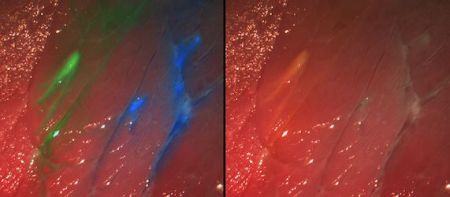Recovery and survival rates in patients suffering from cancer are significantly improved if tumours are removed in their entirety, however it is often very challenging for surgeons to identify and remove tiny clusters of cancer cells. A new camera, which can be used during surgery, enables the visualisation of hidden tumours.
Even the most experienced and knowledgeable surgeons face a challenge when removing cancerous tumours. It is difficult to recognise pre-malignancies and differentiate tumour margins blending into healthy tissue, and doctors depend entirely on their experience when performing such a procedure.
An innovative new camera system can in future support the surgeons during complicated interventions by helping to visualise even the smallest, hard-to-detect malignant pieces of tumour.
How? By displaying fluorescent molecules that ‘paint’ the cancer tissue, making it stand out from healthy tissue. These molecules are injected into the patient’s blood circulation prior to the operation and selectively attach onto the tumor during their trip through the body. By illuminating the corresponding area with a specific wavelength, fluorescence is emitted and the affected tissue glows red, blue, green or any other injected dye colour, differentiating it substantially. Via this procedure, surgeons can identify small clusters of tumours otherwise not visible to the naked eye.
Scientists at the Fraunhofer Project Group for Automation in Medicine and Biotechnology (PAMB), a division of the Fraunhofer Institute for Manufacturing Engineering and Auto- mation (IPA), have researched and developed a multispectral fluorescence camera system, designed to aid surgery. Once completed, the extraordinary camera will have the ability to integrate into a number of medical imaging systems such as surgical endoscopes and microscopes. The high-tech system prototype will be make its debut at the joint Fraunhofer booth at Düsseldorf’s Medica Trade Fair in November.
What takes this camera one step further than previous systems is its ability to
display several fluorescent dyes and the reflectance image simultaneously in real time. This offers the significant advantage of protecting arteries and delicate nerves during surgery by colouring them with dye, rendering them detectable.
Nikolas Dimitriadis, head of the Biomedical Optics Group at PAMB, explains that the visibility of the dye is predominantly dependant on the selection of the correct set of fluorescence filters. These separate the incident excitation wavelengths from the fluorescing wavelengths, setting diseased tissue apart from its surroundings even at very low light intensities.
Only one camera and one set of filters is required to achieve photographs that can present up to four dyes simultaneously. Specific software developed by the team processes and analyses the images within seconds, projecting them onto a screen during surgery. By superposing the fluorescent image onto the normal colour image it becomes possible to visualise considerably more accurate information. Millimeter-sized tumor remnants or metastases are reliably identified on the monitor, increasing survival chances of those cancer patients having surgery under fluorescent light.
Dimitriades goes on to specify that by converting the multispectral fluorescence camera system to other combinations of dye, its employment becomes more adaptable, and he concludes: “One preparation that is already available to make tumors visible with a camera is 5-amino levulinic acid (5-ALA), which leads to an accumulation of a red dye in the tumor. Physicians employ this especially for glioblastomas, one of the most frequent malignant brain tumors in adults.”
It is expected that this pioneering camera system will have passed testing for use with humans as early as next year, with the initial tests with patients suffering from glioblastomas planned for 2014.
Source: Alpha Galileo
6 November 2013
Latest Articles
Cancer, camera, flourescence
Recovery and survival rates in patients suffering from cancer are significantly improved if tumours are removed in their entirety, however it is often very...



























